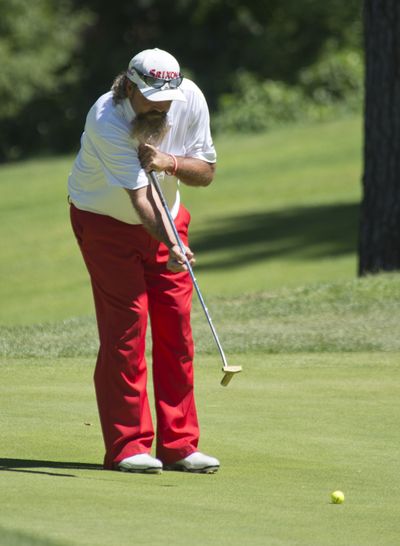Jim Meehan: Golfers with anchored putters must take new stance soon

Billy Bomar has putted sidesaddle nearly his entire golf career.
It’s an unconventional approach, but those who play with or against Bomar quickly learn that the PGA pro and co-owner of Prairie Falls Golf Club can flat roll the ball. One accomplished area collegiate player called Bomar the best putter he’s seen.
Bomar taught his kids, a son who plays high school golf and a daughter who plays professionally overseas, the sidesaddle method.
“It’s the only way I’ve putted,” Bomar said.
Come Jan. 1, Bomar will have to make a change. He will be required to move the butt end of his putter at least a couple of inches away from his upper right arm to comply with rule 14-1b, which prohibits anchoring the putter, with the exception that it can rest against the forearm (see Matt Kuchar).
The United States Golf Association and the Royal and Ancient Golf Club adopted the rule to promote a free swing of the putter. Long and belly putters came under scrutiny when Keegan Bradley (2011 PGA), Webb Simpson (2012 U.S. Open) and Adam Scott (2013 Masters) won majors using long or belly putters.
It stirred hot debate on both sides of the issue. Tiger Woods and Arnold Palmer were among those in favor of the rule change, but many labeled it unnecessary since just 13.6 percent of 2013 tour players used long or belly putters.
Broomstick putters have revitalized the careers of numerous pros, not to mention casual golfers just trying to enjoy the game, who struggled on the greens. Deer Park pro Craig Schuh used a long putter for 18 years to deal with yips that occasionally sent 1½-footers off target.
“I didn’t think (the rule change) was necessary,” Schuh said. “I could see it if it was a huge advantage and you went out and made everything. You still have to make the stroke, hit the right speed and make the right read.”
Avondale pro Dan Porter has always been a quality ball-striker, but years ago he encountered the short-putting blues. Friends in pro-ams needled: “Drive it, stick it, miss it.” He sampled just about every method: claw grip, left hand low, reverse overlap, looking at the hole, eyes closed. He turned to a belly putter from 2012-14.
“It really helped me,” Porter said. “I had trouble keeping the putter square going back and going through, keeping my path straight. I was looking for an answer on shorter putts, 10-footers and in. Those are the scoring shots.”
The game is on to adjust their putting motions, whether they stay with longer putters or switch to conventional ones, to satisfy the new rule. Bomar plans to move his left hand a couple of inches forward. Porter has changed to a 36-inch-long counterbalance putter (additional weight in the grip area and putter head).
“It gets me more of a pendulum (swing),” Porter said. “I spent all winter downstairs in my teaching studio working on my putting, trying to make it a smooth transition. I would say I got pretty close to (2012-14) but not quite as good.”
Schuh now employs a conventional putter instead of the 44-incher he anchored to his chest.
“My assistant (Luke Baker) showed me a grip he used when he was in college,” Schuh said. “I went with that grip and it pretty much cured it.”
What does 14-1b mean for amateurs? If they plan on playing tournament golf, they’ll almost certainly have to abide by 14-1b. If they’re just playing with buddies once or twice a week, probably not, but playing partners might take exception if they’re repeatedly handing $5 bills to pals wielding long putters.
Sadly, the game is going to lose some players who had found solace on the greens with anchored strokes, another blow to a golf industry battling to maintain, let alone grow, its customer base.
Porter and Schuh said tournaments at their courses will follow USGA rules. Bomar is looking into a possible compromise.
“A lot of tournaments allow rangefinders, which are banned in tour and USGA events, so maybe you can put an exception on the rule sheet and have events where (14-1b) isn’t applied,” Bomar said. “To me it’s a shame.
“It saved a lot of amateurs and some professionals from having to quit and in my mind, as a golf course owner and PGA pro, that was good for our game.”